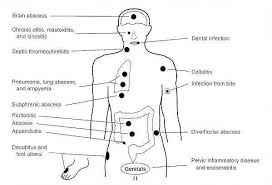
ALSO KNOWN AS
Gas gangrene, clostridial myonecrosis, or necrotizing infections
DESCRIPTION
* This disease is caused when the bacteria in the family of Clostridium (e.g., Clostridium perfringens) infects the body tissue. Clostridium bacteria of this type can only live where there is little or no oxygen (i.e., anaerobic conditions). This occurs in damaged or injured tissues where the oxygen supply is low. It is called "gas" gangrene because the Clostridium bacteria release gas that causes swelling in the surrounding tissue.
* Trauma, Diabetes Mellitus, old age, poor circulation, malignancies of blood cell line, poor nutrition, decrease in number of neutrophils (a type of white blood cell), diseases of the large intestine, and chemotherapy are some of the predisposing risks and causes of gangrene.
SYMPTOMS
* Sudden onset of pain in affected area
* Heart racing
* Drop in blood pressure
* Fever
* Later as the infection progresses:
* Feel severely ill
* Confusion
* Delirium
* Coma
HOW THE DIAGNOSIS IS MADE
* Examination:
1. Wound is foul smelling with a brown/clear, blood-tinged discharge
2. Wound swells and surrounding skin is pale
3. Skin eventually changes from pale to dusky to dark and discolored, containing blood-filled blisters
4. Gas may be felt in the tissues
5. Skin and eyes may turn yellow
* Laboratory findings:
1. Blood cells may hemolyze (burst)
2. Increase in white blood cells
3. Levels of muscle enzyme Creatine Kinase are often elevated with destruction of muscle tissue in gangrene.
4. Anemia in severe cases
5. X-Rays may show gas
* Anaerobic culture will confirm diagnosis (takes too long to come back, so treatment is initiated immediately)
TREATMENT
* Penicillin intravenously
* If allergic to penicillin -- Clindamycin, Tetracycline, Flagyl, Cefoxitin, and Chloramphenicol. All are theoretically (in vitro) active against these Clostridia.
* Surgical debridement (removal of contaminated tissue) of affected area (stops continued spread)
* Other treatment options:
1. Hyperbaric oxygen -- oxygen forced into tissues in an oxygen chamber
2. Polyvalent Gas Gangrene anti-toxin
IF YOU SUSPECT THIS CONDITION
* This is a life-threatening emergency that can lead to rapid death. Seek emergency medical treatment immediately.
SIMILAR CONDITIONS
* Other bacterial infections, such as E. coli, enterobacter, and other anaerobic organisms


No comments:
Post a Comment